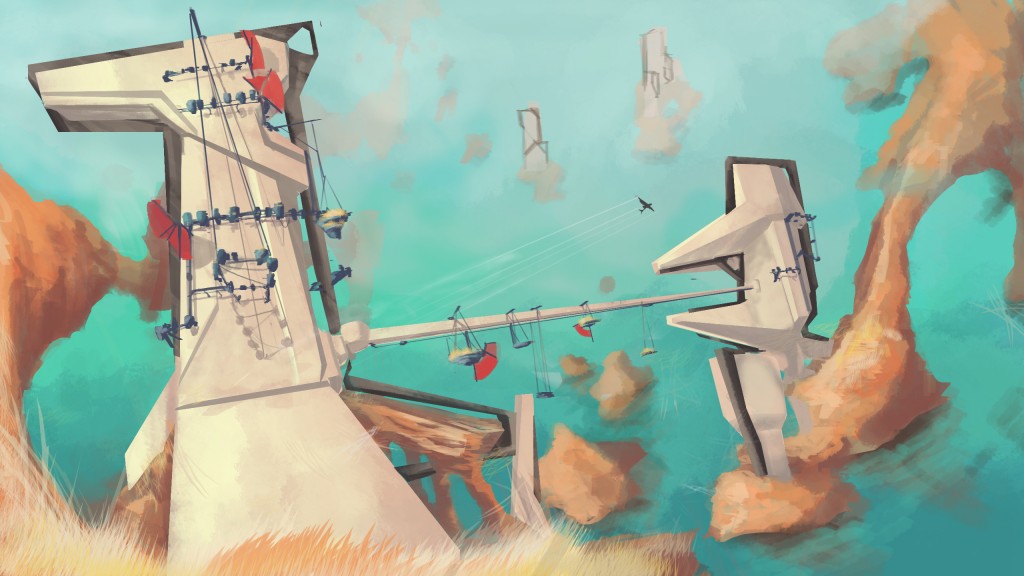A plane flies by overhead, ducking and twisting through mysterious alien ruins on an unknown mission of exploration. The horizon is infinite, as are the mysteries to uncover in the strange, inside-out world of “InnerSpace.”
A group of arts and technology students first conceived the video game when they formed an indie game company, PolyKnight Games, in spring 2014 through the LaunchPad UTD program, a nonprofit educational system that provides assistance and resources to entrepreneurial-minded students.
PolyKnight Games has eight members, all UTD alumni or students except for one member. The friends spent the spring semester in preproduction for what would become “Innerspace” and PolyKnight Games.
The game takes place inside of a 3-D inverted planet, which players have complete freedom to explore in their aircraft.
“‘InnerSpace’ started as an experiment of what would it be like to fly in a physically different space from our own,” said ATEC junior Nick Adams.
The team members said they have a strong dedication to unique, original games using ideas they’ve never seen before. The inverted planet idea for “InnerSpace” originally came out of software engineering senior Tyler Tomaseski’s vision of a flying game without boundaries, in which the sky and the ground would be similar in gameplay.
“Almost all of my game ideas come from an interesting gameplay loop or an interesting change to the way you play a game,” Tomaseski said. “But this is the first idea I’ve had that’s started with a setting.
The world of “InnerSpace” exists inside several planet-sized hollow spheres, or bubbles, each with its own unique aspect or twist. The central sphere is conceptually the uninhabited capital city of an ancient civilization, with additional spheres extending farther out into the civilization’s empire.
“InnerSpace” is strongly focused on exploration and discovery with an untraditional style of storytelling, said ATEC graduate student Eric Brodie.
The narrative is mostly told through the discovery of relics, which, along with providing upgrades for the player’s ship, give the player a glimpse into the civilization’s past. However, the game can be played without ever discovering all there is to know about the world or the story it can tell.
“The thought was to create a space that presents an alien culture or a foreign culture that the player isn’t familiar with and let the player have free reign without context and without purpose,” said ATEC senior Steve Zapata. “The hypothesis is that the player will go into that space with preconceptions.”
Themes of the narrative include actions and reactions that have certain effects on cultures such as the effect Christopher Columbus’ landing had on Native American life.
Players exploring this vast world will encounter massive, artificial intelligence creatures revered as godlike beings by the alien race that once inhabited the spheres. These encounters should be less thought of as boss fights and more thought of as simply a part of the world, though the ship the player controls is mounted with guns to use at the player’s discretion.
“It’s kind of the question of if you give a player a plane with guns and then you put something in front of them, what are they going to do with it?” Brodie said. “And it’s not necessarily to say that there are multiple endings or to say that you’re not supposed to do it — maybe you totally are. In reality, it’s just the player’s unique experience of making that realization.”
The game is currently being financed through the developers’ personal investments as they work out of Tomaseski’s bedroom. They have created a crowdfunding page for “InnerSpace” on Kickstarter with the hopes of raising $25,000 to fund the development of the game and pay assistant developers helping with the project. Incentives for pledging include items such as custom in-game content, 3-D models of the plane and signed canvas prints of the game’s art.
If the team reaches its funding goal on Kickstarter, the members plan to dedicate the next year to finishing the game for release, Tomaseski said.
“We know that what we release speaks for us as developers but also speaks for what we’ll be doing in the future,” he said. “So it’s very, very important to us, not only as professionals but also as developers with standards and morals, that we develop the game that people were promised.”











